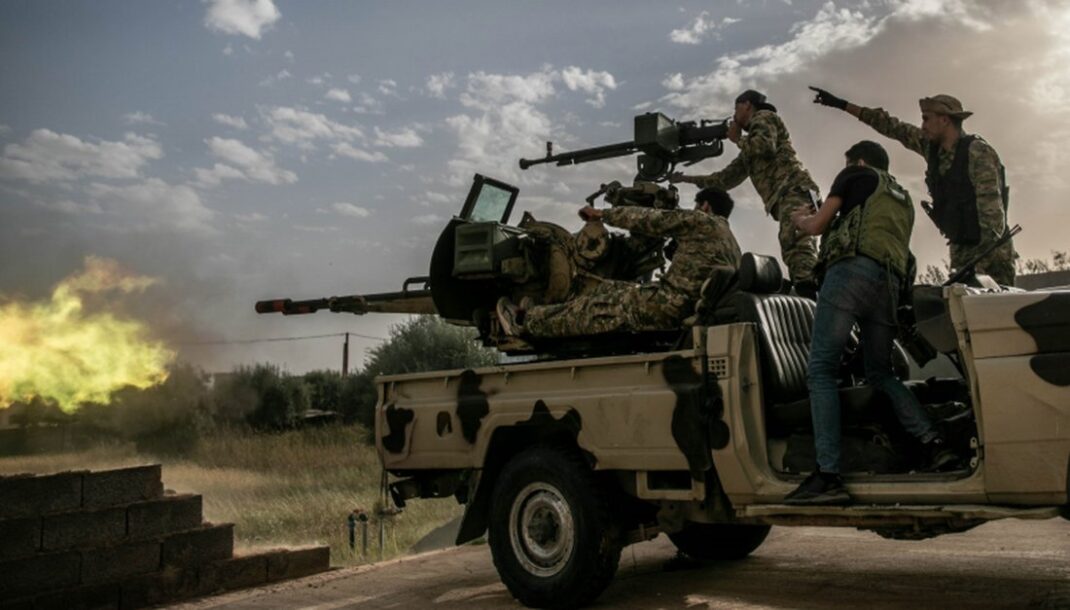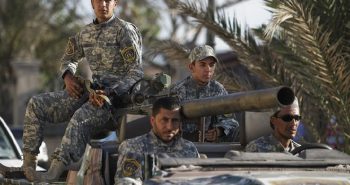By Emadeddin Badi
 Libya’s security sector has become virtually unrecognizable from what it was a decade ago owing to the transformations brought about since the 2011 revolution.
Libya’s security sector has become virtually unrecognizable from what it was a decade ago owing to the transformations brought about since the 2011 revolution.
This evolution has implications for any attempt to usher in short-term and interim security arrangements – including brokering ceasefires or improving security provision and policing capabilities – as well as longer-term security sector reform (SSR) efforts.
PART (VI)
The scramble for legitimacy and Tripoli’s quartet
By mid-2015, addressing Libya’s institutional split had become a matter of priority for European states and the United States.
Indeed, foreign security imperatives – centred around countering IS’s attempt to extend its footprint in Sirte and beyond, and addressing migration flows through Libya’s shores – had galvanized Brussels and Washington into backing a political process to identify united Libyan authorities they could partner with to tackle these issues.
In 2015 the UN-brokered political dialogue between authorities in eastern and western Libya culminated in an agreement in Skhirat, Morocco, in December – leading to the formation of the Government of National Accord (GNA).
To avoid a relapse into insecurity, the agreement also included clauses on security arrangements. Certain armed groups, however, instrumentalized these clauses, seeking to capitalize on the newly formed body’s international legitimacy.
In practice, armed groups that had formed – and evolved – in Tripoli after 2011 used the body’s newfound international clout to dislodge other armed groups (most notably those from Misrata) from Tripoli.
They also opportunistically sought to obtain an affiliation with a ministry aligned with the GNA, shielding themselves from criticism by folding themselves into the newly internationally recognized government’s authority.
The Tripoli Revolutionaries’ Brigade, the Special Deterrence Force, the Abu Salim Central Security Directorate, and the Nawasi Brigade later became known as the “Tripoli cartel” as the quartet carved Tripoli among themselves, developing illicit revenue-generation schemes and infiltrating state institutions as they gradually grew more predatory.
Following the Skhirat agreement, Libyan authorities were also under pressure to act to curtail migration owing to the European Union’s priorities, which sought to further strengthen its border externalization policies.
This momentum trickled down at the communal level, leading armed groups to reconvert themselves into counter-smuggling agents, while integrating state enforcement agencies, such as the border and coastal guards.
This process further contributed to the hybridization of Libya’s security landscape – to the detriment of border and coastal guard’s enforcement capacities.
Other armed actors capitalized on Western policy priorities in the field of “counterterrorism”, namely portraying themselves as security providers with a heavy focus on curbing crime and cracking down on terrorist sleeper cells.
During the years that followed, politicians and businessmen with links to the GNA established alliances of convenience with Tripoli’s armed groups, or de-facto sponsored them.
In practice, this led to a decrease in violence as the cartel consolidated control over downtown Tripoli. The trade-off for the improvement in security was Tripoli’s cartel-dominated, state-derived revenue-generation mechanisms, with the connivance of the political elite.
Their schemes for revenue generation varied from licit to illicit and included, among others, local taxation, contracts for security provision signed with various institutions, letters of credit fraud through the Central Bank of Libya, and salaries.
As the years passed, these armed groups also proceeded to infiltrate the institutions they provided security for, attracting further antagonism from outsiders. Even armed groups with former enmities such as those from Zintan and Misrata, and their respective constituencies, were united in their disapproval of the cartel’s behaviour.
The latter’s continuous and unabated profiteering brought another conflict dynamic to the fore, namely grievances over the centralization of Libya’s economic system. Socially speaking, Tripoli’s armed groups also attempted to improve their relationship with local communities.
Some focused on recruiting members from particular neighbourhoods where they had a stronger level of social legitimacy, while certain armed factions sought to “professionalize” themselves and their rank and file by embedding old regime elements within their leadership.
To this end, armed factions also began to communicate their activities – namely the confiscation of illegal goods, raids, arrests, and so on – increasingly via social media.
This was seemingly to mainstream their “anti-criminal” stance to promote themselves as security providers to local communities and to domestic and international authorities more broadly.
The Special Deterrence Force: The instrumentalization of anti-criminality
Many western Libya groups viewed the Special Deterrence Force (SDF) as the most adept at using these public relations efforts. It also benefitted from the expertise of Gadaffi-era security and intelligence officials, which it embedded within its hierarchy to improve efficiency thus contributing to its superior performance.
The SDF was established in 2013 by Abdulraouf Kara, one of the members of Tripoli’s Military Council (established during the liberation of Tripoli in August 2011), an entity led by Abdelhakim Belhaj.
Kara – along with several others – had been part of the Sug Aljumaa Martyrs Brigade, an armed group primarily staffed with residents of the Sug Aljumaa neighbourhood in Tripoli (an area renowned for its opposition against Gadaffi).
The SDF formed as a result of a rift within the Sug Aljumaa Martyrs brigade over a leadership dispute. Kara and the current head of the Nawasi Brigade were both leaders of clusters within the Sug Aljumaa Martyrs Brigade, Sug Aljumaa’s main armed group.
Leading a group of men under the banner of “Saraya al Isnad 2” (as part of the Sug Aljumaa Martyrs Brigade), Kara set his sights on Mitiga and based his headquarters in the area, thus founding today’s SDF.
It is widely believed that Nawasi and SDF’s positive (or ambivalent) relationship, and the lack of conflict between the forces in subsequent years, is primarily due to the fact that the two forces are staffed with combatants that originate from the neighbourhood of Sug Aljumaa in Tripoli.
At the time of its establishment, SDF began with around 50 breakaway members from the Sug Aljumaa Martyrs Brigade. From 2013 to 2020, it grew to comprise between 700 and 900 members, split between policing units and combatants.
The number of administrative staff (those doing administrative work and others embedded into investigative units) is estimated to be 40. The group is affiliated with the Ministry of Interior (MoI), under which it still operates.
The SDF is a localist force that relies on the social legitimacy derived from the social roots of its members within its area of operation and headquarters; however, the armed group operates on the basis of the ideology of its leaders rather than pursuing “Sug Aljumaa’s interests”.
In fact, recruitment within the SDF does not rely solely on social or localist factors; in previous years, the force has managed to amalgamate a number of Salafi fighters with residents of Sug Aljumaa, as well as combatants from other areas of Tripoli, into its ranks.
In addition to “localism” and communal factors, the ideology of Madkhali Salafism is one of the factors influencing the SDF’s decision-making and cooperation with other actors. Leadership within the SDF is approached through the model of “shura”” (that is, collective decision-making) between influencers within the force – a clear sign of the significant influence of the Salafi trend.
The SDF is also linked to a wide-spanning and multi-faceted network of Salafist preachers in Libya. This is one of the reasons why the SDF shared an aversion toward the Muslim Brotherhood and worked to limit the influence of perceived Islamist-linked armed groups in Tripoli after 2014.
Ideology also allowed the group to transcend national divides as it cooperated with other Salafist Brigades in Kufra, Sabratha, and Sirte, among others, despite the fact most of these areas fell under the nominal control of eastern authorities that were not aligned to the SDF.
The leadership of Kara, along with the Salafi Madkhali ideology within the group and its recruitment of former Gadaffi-era regime officials, allowed the SDF to grow into one of Tripoli’s most organized factions.
The SDF geared its internal structure towards optimizing command and control and adopted a strategy that divided its rank and file into smaller armed groups supervised by a leader and an associate to take charge of these sub-units.
This approach greatly enhanced coordination and organization within the SDF, especially since each “smaller armed group” has a specific “specialization”. While some units are specialized in raids, others act as a support force in combat or engagement situations.
Some sub-units have also developed the capacity to deal with explosives and improvised explosive devices (IEDs), while others specialize in reconnaissance.
Part-time paramedic units are also fully dedicated to the SDF. The developments of the SDF since 2013 highlights the influence that ideology, social roots, leadership, and external developments can have on an armed group’s social cohesion and its potential role as a security provider.
It also raises important policy-related questions about the engagement of international actors with an armed group whose activities are – at least in part – influenced by religious sermons and fatwas.
The LAAF asserts control over eastern Libya
Meanwhile, in Cyrenaica, Haftar leveraged the LAAF’s territorial control over eastern Libya and the oil crescent to develop state-derived revenue-generation mechanisms.
By seemingly emulating the Egyptian military’s approach to economic domination, Haftar established the LAAF’s Military Investment Authority of Public works – an entity managed by individuals close to LAAF’s Central Command.
The institution was used as a medium to predate over the private and public sector of eastern Libya.
The Central Bank in Al-Bayda also oversaw the sale of over 30 billion dinars worth of bonds outside the official purview of the Tripoli-based financial system. These were purchased by the parallel entity in Beyda and subsequently used to finance the LAAF.
The Beyda-based parallel central bank also received an undisclosed amount of Russian-printed “counterfeit” banknotes, which were distributed in eastern and southern Libya, further complicating prospects of unifying Libya’s Central Bank, which had been divided in the aftermath of the 2014 war.
The LAAF’s diversification in sources of funding was also concomitant with an effort by Haftar to centralize control over the panoply of armed groups and individuals aligned under its command.
A series of decrees and decisions, some of which were informally mainstreamed, were passed in an effort to “coup-proof” the LAAF and ensure that no particular social constituency, ideological trend, or tribe dominated it and represented a threat to Haftar’s leadership.
Even the eastern federalist movement80 was subdued and repressed by the Central Command of the LAAF, with several federalist actors forced to submit to Haftar’s nationalist ambitions owing to the extensive foreign support he benefitted from, and the prospect that his quest for total consolidation of control over Libya would see them reap the rewards of having backed him at an early stage.
Overall, Haftar’s divide-and-rule strategy within the LAAF was reminiscent of the policy used by Gadaffi to dominate Libya’s fractious landscape.
Much like Gadaffi, the side-effect of such an approach was that the LAAF became an entity that would only remain cohesive if Haftar remained at its helm. Haftar also engaged in “coupproofing” while the LAAF gradually asserted control over eastern Libya – launching a two-year siege on Derna before capturing the city after a year of military campaigns.
The war in Derna also had deep social roots and reverberations.81 Several tribes and groups mobilized under Haftar towards the city, viewed by then pro-Haftar figures as Islamists’ last stronghold in eastern Libya.
Mobilized units included the Saiqa Brigade, the predominantly Madkhali Salafist Tarik Ben Ziyad Brigade, and the Awagir-led Avengers of Blood – a group of support forces that framed their mobilization as retribution for the murder of their relatives by “terrorists”.
These groups targeted anti-LNA tribes and families from Derna who they accused of harbouring extremists. The LAAF’s main opponent in Derna was the Derna Mujahideen Shura Council (DMSC), an Islamist group that espoused a hard-line Islamist vision for the Libyan state and evinced ideological affinities to Al Qaida, which had co-existed with and subsequently fought IS in Derna before Haftar’s siege.
Derna’s war further tore at eastern Libya’s social fabric as dozens of families from Derna were displaced and hundreds were imprisoned.
Overall, the centralization that characterizes the leadership of the LAAF – essentially centred around Haftar’s persona – implies that proximity to him and his Ferjan tribe enables groups to act with impunity, but also to profit from the LAAF’s various revenue streams.
Local groups co-opted, coerced, or recruited by the LAAF Central Command do not necessarily share the leadership’s ambitions of asserting control over the entire territory, particularly those with more localistic inclinations that prefer to consolidate security over particular areas or neighbourhoods.
This discrepancy between the LAAF’s leadership and local groups mobilized under its banner explains why each war fought by the LAAF has seen a different set of actors and units deploy on its behalf, often depending on their perceived self-interest.
For instance, while the Awagir have mostly mobilized for the conflicts in eastern Libya – namely Benghazi and Derna – their subsequent mobilization towards southern and western Libya has been limited, a dynamic that demonstrates that their perceived self-interest does not always align with Haftar’s.
…
to continue
***
Emadeddin Badi is an independent researcher that specializes in governance, post-conflict stabilization, security sector governance and peacebuilding. He currently works as an advisor for the Geneva Centre for Security Sector Governance (DCAF) for Libya and a Senior Analyst for the Global Initiative against Transnational Organized Crime.
__________





